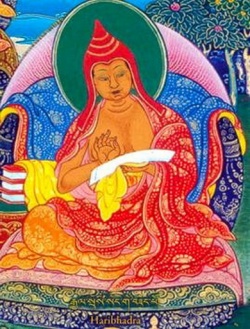Haribhadra (Buddhist philosopher)
Haribhadra (Skt. Haribhadra, Tib. སེང་གེ་བཟང་པོ་, Senge Zangpo, Wyl. seng ge bzang po) (late 8th C.) was a great pandita and master of the prajnaparamita teachings. He received instructions directly from Maitreya and composed the Sphutartha, which is the most celebrated commentary on Maitreya's Abhisamayalankara. Taranatha says he was a disciple of Shantarakshita. He was a teacher of Buddhajñanapada. Haribhadra (8th century): One of the "seventeen great panditas" and commentator on Asanga's Ornament of Clear Realization in Clarifying the Meaning.
Haribhadra. (T. Seng ge bzang po) (c. 800). Indian Buddhist exegete during the Pāla dynasty, whom later Tibetan doxographers associate with the Yogācāra-*Svātantrika syncretistic strand of Indian philosophy. He may have been a Student of Śāntarakṣita and was a contemporary of Kamalaśīla; he himself lists Vairocanabhadra as his teacher. Haribhadra is known for his two commentaries on the Aṣṭasāhasrikāprajñāpāramitāsūtra ("Prajñāpāramitā in Eight Thousand Lines"): the longer Abhisamayālaṃ kārālokā-Prajñāpãramitãvyãkhyã, and its summary, the Abhisamayālaṃkāravivṛti.
He is also known for his recasting of the twenty-five-thousand-line version of the prajñāpāramitā (Pañcaviṃśatisāhasrikāprajñāpāramitāsūtra) in a work entitled the Le'u brgyad ma in Tibetan. Each of these works is based on the interpretative scheme set forth in the Abhisamayālaṃkāra ("Ornament for Clear Realizations"), a guide to the Pañcaviṃśati that Haribhadra explicitly attributes to Maitreya.
His Abhisamayālaṃkārālokā builds upon Pramāṇa, Madhyamaka, and Abhidharma literature and was extremely influential in Tibet; its summary (known as "’grel pa don gsal" in Tibetan) is the root text (rtsa ba) for commentaries in the Gsang phu ne’u thog monastery tradition originating with Rngog Blo ldan shes rab. It is the most widely studied prajñāpāramitā commentary in Tibetan Buddhism to the present day. Haribhadra is known for his explanation of a jñānadharmakāya (knowledge truth-body) in addition to a svābhāvakāya, viz., the eternally pure dharmadhātu that is free from duality.
He is characterized as an alīkākāravādin ("false-aspectarian") to differentiate him from Kamalaśīla, a satyākāravãdin ("true- aspectarian") who holds that the objects appearing in the diverse forms of knowledge in a buddha's all-knowing mind are truly what they seem to be. He cites Dharmakīrti frequently but appears to accept that scripture (āgama) is also a valid authority (pramāṇa).
There are two principal commentaries on his work, by Dharmamitra and Dharmakīrtiśrī. Buddhaśrījñāna (or simply Buddhajñāna) was his disciple. The Subodhinī, a commentary on the Ratnaguṇasaṃcayagāthā, is also attributed to him. (Source: "Haribhadra." In The Princeton Dictionary of Buddhism, 345. Princeton University Press, 2014. http://www.jstor.org/stable/j.ctt46n41q.27.)
Writings
- Śāstravṛtti (popularly known as the Sphutartha)
- Light on the Ornament (Skt. Abhisamayālaṃkārālokā), a commentary on the Sutra in Eight Thousand Lines
- Easy-to-Comprehend Commentary on the Difficult Points of the Verse Summary
- Eight Chapters on the 25,000
Further Reading
- David Seyfort Ruegg, The Literature of the Madhyamaka School of Philosophy in India, Wiesbaden: Harrassowitz, 1981, pp. 101-103
- Lobsang N. Tsonawa, Indian Buddhist Pandits from The Jewel Garland of Buddhist History, Dharamsala: Library of Tibetan Works and Archives, 1985.
Source
Haribhadra (Chinese: 師子賢, pinyin: Shīzixián, Tib. seng-ge bzang-po) was an 8th-century CE Buddhist philosopher, and a disciple of Śāntarakṣita, an early Indian Buddhist missionary to Tibet. Haribhadra's commentary on the Abhisamayalankara was one of the most influential of the twenty-one Indian commentaries on that text, perhaps because of its author's status as Shantarakshita's student. Like his master, Haribhadra is retrospectively considered by Tibetan doxographical tradition to represent the Yogacara Svatantrika Madhyamaka school.
Haribhadra's interpretation of the Abhisamayalankara, particularly his four-kaya model, was controversial and contradicted the earlier normative interpretation popularized by Vimuktasena. Haribhadra claims, that Abhisamayalamkara chapter 8 is describing Buddhahood through four kayas: svabhavikakaya, dharmakaya, sambhogakaya and nirmanakaya. Haribhadra's position was in turn challenged by Ratnākaraśānti and Abhayakaragupta. In Tibet the debate continued, with Tsongkhapa championing Haribhadra's position and Gorampa of the Sakya school promoting the other.
